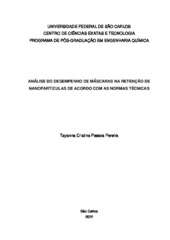Análise do desempenho de máscaras na retenção de nanopartículas de acordo com as normas técnicas
Abstract
In early 2020, the SARS-CoV-2 virus caused a disease known as COVID-19 that caused a worldwide pandemic. As a result, there was an increase in the demand for PPE (masks, aprons, gown, etc.) in the hospital environment. With the growing alarming numbers of infected around the world, WHO recommended that the population also wear masks for their protection, increasing the consumption of this PPE, leading to a shortage of masks in the world market. Within this context, the understanding of the difference between the types of masks and the standards that exist on the characterization of these is very important. Thus, the present work objectives to study the current standards (American, European and Brazilian) and propose improvements in the characterizations of filtering materials. Therefore, this work consists of seeking innovation in the development of protocols to characterize masks. Eight masks were tested, six surgical masks and two respirators, to assess the best way to characterize them. The tests were: determination of permeability, fiber diameter through SEM images, particle filtration efficiency and pressure drop (breathability). These last two tests are carried out using the current standards as a basis. Some changes were made to evaluate the interference in the tests. The combination of filtration efficiency and breathability is very important for the quality of the mask. The permeability tests were consistent with the pressure drop tests, since the mask that obtained the highest permeability was the one with the lowest pressure drop. The results obtained by all surgical masks did not accomplish desired results by the standards, in any test condition. Only the respirators presented results close to what is stipulated by the standard (95%) at the lowest surface speed tested (6,51 cm/s). The standards do not use the correct conditions for the tests, since tests should be performed at speeds that simulate human respiratory activity. An example of this is the fact that the current Brazilian Standard and the American Standard allow a wide range in face velocity (0,5 to 25 cm/s) that do not represent any human activity, since the speed of a sneeze can vary between 20 and 50 m/s, that is, at least 100 times higher than the maximum limit proposed by the standard. The breathing of a person at rest is around 6 L/min. Thus, an ideal flow rate for performing the tests would be flows close to this value. In this work, tests were performed, following the standards, using the flow rate of 7 L/min and the masks did not present good performance, with the best result being close to 56% efficiency in the collection of particles of 100 nm. This low performance can be related to the size of the particles that the tests were carried out, because surgical masks are recommended for use against droplet-transmitted pathogens and respirators (PFF) are indicated for diseases transmitted by aerosols. And since the test was performed for 100 nm particles (aerosols) the surgical masks performed poorly. In general, this work made it possible to evaluate parameters that directly interfere with the results of the tests that are proposed by the technical standards for surgical masks. Concluding that the tests must be reviewed and define better parameters (concentration of aerosol particles, particle size, test flow rate, test area or surface velocity) and define the equipment that must be used according to the counting and classification efficiency of the particles.
Collections
The following license files are associated with this item:

